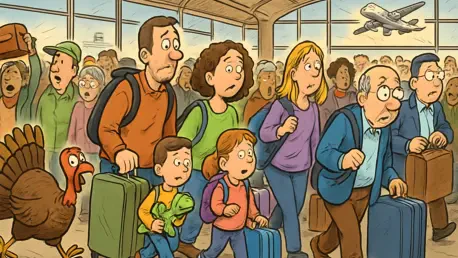As Thanksgiving approaches this year, an unprecedented wave of travel is set to sweep across the nation, with nearly 82 million Americans projected to journey at least 50 miles from home between November 25 and December 1, marking a significant increase of 1.6 million travelers compared to last year. This staggering figure, reported by AAA in partnership with S&P Global Market Intelligence and INRIX, establishes a new record for the holiday period. The surge underscores Thanksgiving’s unmatched status as the busiest travel holiday, outpacing others like Memorial Day or Independence Day. It reflects a deep cultural tradition of gathering with family and friends, often at the cost of navigating crowded roads, packed airports, and unexpected delays. Stacey Barber, Vice President of AAA Travel, notes that this willingness to endure logistical challenges highlights a collective desire to create cherished memories. These projections not only signal a spike in travel volume but also point to a growing enthusiasm for holiday journeys, painting a vivid picture of a nation on the move to celebrate togetherness.
Dominance of Road Travel and Rising Alternatives
Thanksgiving travel this year continues to be dominated by road trips, with approximately 73 million Americans—nearly 90% of all holiday travelers—choosing to drive to their destinations. This number reflects a notable rise of 1.3 million drivers compared to last year, emphasizing the enduring appeal of car travel for its flexibility and familiarity. However, the journey is not without challenges, as gasoline prices, which averaged $3.06 per gallon last year, and the potential for vehicle issues loom large. Last Thanksgiving saw around 600,000 roadside assistance calls for problems like dead batteries and flat tires, a reminder of the importance of vehicle maintenance before hitting the road. For many, driving offers a sense of control over travel plans, despite the inevitable traffic snarls that come with peak holiday periods.
Beyond the roads, other modes of transportation are carving out a growing share of the holiday travel landscape. Air travel, though less dominant, is expected to involve about 6 million domestic passengers, marking a modest 2% increase from the previous year, with average roundtrip tickets costing around $700. Travelers looking to save on airfare might consider flying on Thanksgiving Day itself, which often has lower fares compared to peak return days like Sunday. Additionally, alternative options such as bus, train, and cruise travel are gaining traction, with 2.5 million people opting for these methods, an 8.5% uptick from last year. The rise in cruising, particularly family-friendly trips to the Caribbean, signals a shift toward pre-planned, hassle-free vacations. This diversity in travel choices reflects a broader trend of balancing convenience, cost, and personal preferences during the holiday rush.
Top Destinations Drawing Holiday Crowds
When it comes to where Thanksgiving travelers are headed, Florida emerges as the undisputed domestic favorite, with cities like Orlando, Miami, Fort Lauderdale, and Tampa topping the list. Orlando, in particular, stands out due to its world-renowned theme parks and proximity to major cruise ports, attracting families seeking both adventure and milder late-November weather. These destinations cater to a wide range of vacationers, from those chasing thrills at amusement parks to others embarking on holiday cruises. The Sunshine State’s appeal lies in its ability to offer a festive escape that combines entertainment with a break from colder climates, making it a magnet for millions during this holiday period.
Internationally, Thanksgiving travel reveals a fascinating mix of preferences, showcasing the diverse motivations behind holiday getaways. European cultural hubs like Paris, Amsterdam, and Vienna draw travelers eager for historical exploration and seasonal charm, while tropical destinations such as Cancun and Punta Cana in the Caribbean promise relaxation under sunny skies. Unique warm-weather spots like Sydney, Australia, also feature prominently, appealing to those seeking an unconventional holiday experience. This variety highlights how Thanksgiving travel transcends a single purpose, accommodating everything from heritage-focused trips to pure leisure escapes. The global spread of destinations illustrates a broad spectrum of traveler demographics, each prioritizing different aspects of the holiday journey.
Navigating Traffic Congestion and Timing Strategies
One of the biggest obstacles facing Thanksgiving travelers this year is the inevitable traffic congestion, particularly during peak periods leading up to and following the holiday. INRIX forecasts that the Tuesday and Wednesday before Thanksgiving will see the heaviest road traffic, with return journeys on Sunday afternoon also expected to be significantly delayed. Major metro areas like Los Angeles, New York, and Washington, DC, are bracing for travel times that could increase by as much as 166% compared to normal conditions. Specific routes, such as New York to the Hamptons, may experience delays of up to 163%, turning short trips into lengthy ordeals. These projections paint a challenging picture for drivers navigating urban corridors during the holiday rush.
To mitigate the impact of such congestion, experts advise strategic timing as a critical tool for a smoother journey. Departing early in the morning or outside typical peak hours can help avoid the worst bottlenecks, though external factors like adverse weather or sudden accidents remain unpredictable variables. Travelers are encouraged to stay informed through local traffic updates and to build extra time into their schedules for potential disruptions. Flexibility is key, as even the best-laid plans can be upended by unforeseen road conditions. By prioritizing off-peak travel windows and maintaining awareness of real-time developments, holiday drivers stand a better chance of reaching their destinations without excessive stress or delay.
Addressing Safety Risks During the Holiday Rush
Safety remains a paramount concern as millions embark on Thanksgiving journeys, with impaired driving posing a particularly grave threat. Data from the National Highway Traffic Safety Administration reveals that 868 fatalities resulted from drunk-driving crashes during Thanksgiving periods between 2019 and 2023, accounting for a staggering 35% of all traffic deaths during the holiday. This alarming statistic underscores the urgent need for responsible decision-making on the road. Advocates, including AAA, strongly recommend designating sober drivers, utilizing rideshare services, or opting for public transit to prevent tragic outcomes. The message is clear: no holiday celebration is worth the risk of driving under the influence.
In addition to the dangers of impaired driving, vehicle breakdowns present another significant safety hazard during this busy travel season. Last year alone, nearly 600,000 emergency roadside assistance calls were made for issues as preventable as flat tires, dead batteries, and empty fuel tanks. These incidents highlight the importance of thorough pre-trip vehicle inspections to ensure cars are in reliable condition before departure. Checking tire pressure, battery life, and fuel levels, as well as packing an emergency kit, can make the difference between a minor inconvenience and being stranded. Proactive preparation, combined with safe driving practices, is essential to safeguarding travelers amidst the heightened risks of the holiday period.
Looking Ahead: Planning for a Record-Breaking Holiday
Reflecting on past Thanksgiving travel seasons, it’s evident that the record-breaking numbers this year, with 81.8 million Americans having journeyed far and wide, marked a historic moment in holiday mobility. The dominance of road travel, alongside the steady growth of air and alternative modes like cruising, painted a dynamic picture of how people chose to connect with loved ones. Safety challenges, from the heartbreaking toll of impaired driving to the frequent vehicle breakdowns, reminded everyone of the stakes involved in holiday journeys. Congestion in major urban areas tested the patience of millions, while diverse destinations, from Florida’s sunny shores to Europe’s cultural centers, fulfilled a wide array of travel dreams.
Moving forward, travelers can take actionable steps to ensure smoother experiences in future holiday seasons. Booking flights, car rentals, or accommodations well in advance, especially in high-demand areas, can secure better rates and availability. Embracing early morning travel slots and staying updated on traffic or weather alerts will help dodge peak delays. Above all, prioritizing safety through sober travel plans and vehicle readiness remains non-negotiable. For transportation authorities, this data signals a need for enhanced safety campaigns and improved traffic management during peak times. As holiday travel continues to grow, adapting with strategic planning and a commitment to safety will be crucial for balancing the joy of reunion with the realities of mass mobility.









